While most people are familiar with coin collecting, many don’t realize that some of the smallest coins in their pockets could be worth far more than their face value. One such example is the 1973 Lincoln penny. But how can you tell if your 1973 pennies are actually valuable?
In this article, we’ll explore what determines the value of a 1973 penny. We’ll cover the basics of coin grading, what it means for a coin to be in mint state, and what errors to look for that could significantly increase its worth.
1973 Penny History

U.S. pennies have not always featured the portrait of Abraham Lincoln. Prior to the release of the 1909 commemorative Lincoln penny, it was generally considered inappropriate to depict real people on coins. Instead, coins commonly showcased symbolic figures such as Lady Liberty. This policy changed to honor the 100th anniversary of the birth of Abraham Lincoln, the 16th president of the United States. The idea was inspired by then-President Theodore Roosevelt, who admired a design by Victor D. Brenner.
For the first fifty years, the reverse side of the penny displayed two sheaves of wheat. However, in 1959, the design was changed to commemorate Lincoln’s 150th birthday. The new reverse featured the Lincoln Memorial and remained in use until 2009, when four different reverse designs were released to depict various stages of Lincoln’s life. In 2010, the reverse design was replaced by the “Union Shield.”
Unlike the reverse, the obverse has remained mostly unchanged since Lincoln pennies were first minted in 1909. One notable alteration was the removal and later restoration of the designer’s initials. While Brenner’s initials appeared on the earliest coins, they were removed and did not permanently reappear until 1918.
The 1973 Silver Penny
The so-called “silver penny” from 1973 is not actually silver but made of aluminum. Over 1.5 million of these aluminum pennies were produced, though only a few survived the official destruction. These coins were minted in 1974 but bear the 1973 date. The aluminum pennies were created as an experiment to find a copper alternative, but they frequently jammed in vending machines, leading to the project’s cancellation.
Mary Brooks, the Mint Director at the time, ordered the retrieval of all aluminum pennies, but at least fourteen remain missing. These coins are illegal to own or trade. Despite that, their value is estimated to be around $250,000 each.
1973 Lincoln Penny Details
- Category: Lincoln Penny
- Mints: Philadelphia, Denver, San Francisco
- Obverse Designer: Victor D. Brenner
- Reverse Designer: Frank Gasparro
- Edge: Smooth
- Diameter: 19.05 mm (0.75 inches)
- Thickness: 1.52 mm (0.0598 inches)
- Weight: 3.11 grams (0.1097 ounces) (Note: The original text incorrectly states 2.5 grams—this was not true until the 1982 zinc transition)
- Composition: 95% copper, 5% tin and zinc
- Face Value: $0.01
- Melt Value: $0.0272 (based on copper content)
The Obverse of the 1973 Lincoln Penny
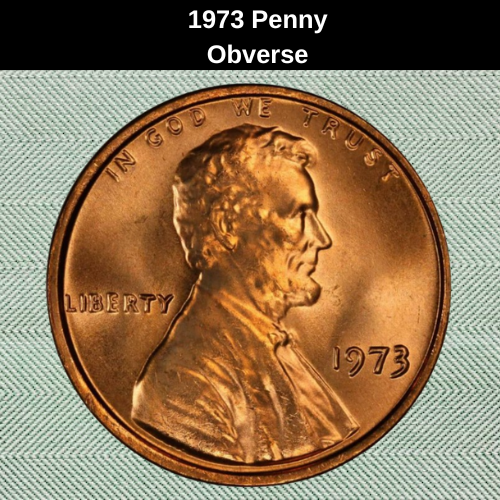
The obverse, or “heads” side, of the 1973 Lincoln penny features a right-facing portrait of President Abraham Lincoln, which is why this coin is commonly referred to as the Lincoln penny.
Above Lincoln’s head is the national motto “IN GOD WE TRUST,” inscribed in capital letters. Behind his head, along the left rim, appears the word “LIBERTY,” also in capital letters.
At the base of Lincoln’s bust, near the shoulder, are the initials VDB, representing the coin’s original designer, Victor David Brenner. These initials were not always included, as their initial appearance in 1909 sparked controversy due to their prominence.
In front of Lincoln’s profile, just below the bow tie, is the year “1973.” Directly beneath the date is the mint mark (D for Denver, S for San Francisco), unless the coin was struck in Philadelphia, in which case no mint mark appears.
The Reverse of the 1973 Lincoln Penny
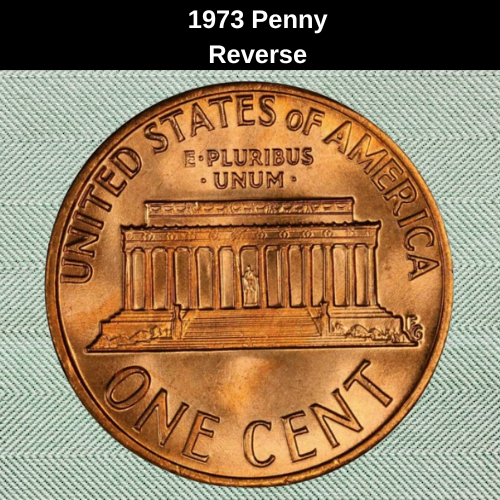
The 1973 Lincoln penny features the second reverse design used in the series. Originally, Lincoln cents had a Wheat Ear reverse (two wheat sheaves), but in 1959, to celebrate the 150th anniversary of Abraham Lincoln’s birth, the design was updated.
This newer reverse showcases the Lincoln Memorial at the center. If you look closely, you can even see a tiny representation of Lincoln’s statue within the Memorial, mirroring the real monument in Washington, D.C.
- Along the top rim, the inscription “UNITED STATES OF AMERICA” is displayed in capital letters.
- Just above the Memorial sits the Latin phrase “E·PLURIBUS·UNUM” (“Out of many, one”).
- The denomination “ONE CENT” is inscribed along the bottom rim, also in capital letters.
- To the right of the Memorial steps, you’ll find the initials FG, representing Frank Gasparro, the reverse designer.
1973 Lincoln Penny Value Chart
(Values for Red uncirculated coins based on market standards)
| Mint Mark | Good (G-2) | Fine (F-12) | Extremely Fine (EF-40) | Uncirculated (MS-63) | Mint State (MS-65) |
|---|---|---|---|---|---|
| 1973 (No Mint Mark – Philadelphia) | – | – | – | $7 | $15 |
| 1973-D (Denver) | – | – | – | $3 | $16 |
| 1973-S (San Francisco) | – | – | – | $8 | $18 |
Note: These prices refer to red versions of the 1973 Lincoln penny in uncirculated condition. Coins with brown or red-brown tones typically have lower market values.
1973 Penny Grading
Like all collectible coins, the 1973 Lincoln penny is graded using the Sheldon Scale, a standardized system that assesses a coin’s condition. The scale ranges from P-1 (Poor) to MS-70 (Mint State Perfect).
- Coins intended for circulation are graded with the abbreviation MS (Mint State).
- Proof coins, which are specially made for collectors, are graded with PR to differentiate them.
Sheldon Scale Overview
| Grade | Description |
|---|---|
| 1 | Poor (Basal State) |
| 2 | Fair |
| 3 | Very Fair |
| 4 – 6 | Good |
| 7 – 10 | Very Good |
| 12 – 15 | Fine |
| 20 – 30 | Very Fine |
| 40 | Extremely Fine |
| 50 | About Uncirculated |
| 60 | Mint State (lowest MS grade) |
| 65 | Mint State (high quality) |
| 70 | Mint State (perfect condition) |
1973 Penny Value and Varieties Guide
1973 No Mint Mark Penny Value
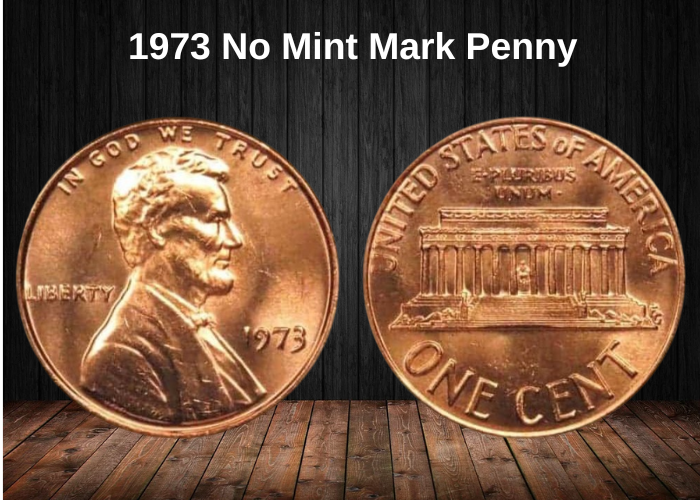
Type: Lincoln Penny
Edge: Smooth
Mint Mark: None
Mint Location: Philadelphia
Total Minted: 3,728,245,000
Year: 1973
Face Value: $0.01
Price Range: $0.05 – $7.50
Nearly four billion 1973 Lincoln pennies were minted in Philadelphia. These can be identified by the absence of a mint mark below the date. Generally, these pennies are not considered rare. In circulated condition, they are worth about $0.05, primarily due to their copper content. Pennies in uncirculated condition can fetch around $7.50.
However, exceptions exist for rare specimens with high Sheldon scale grades. For example, a 1973 penny graded MS67+ RD (indicating a deep red color) by the Professional Coin Grading Service sold at auction in 2022 for $3,960.
1973 D Penny Value
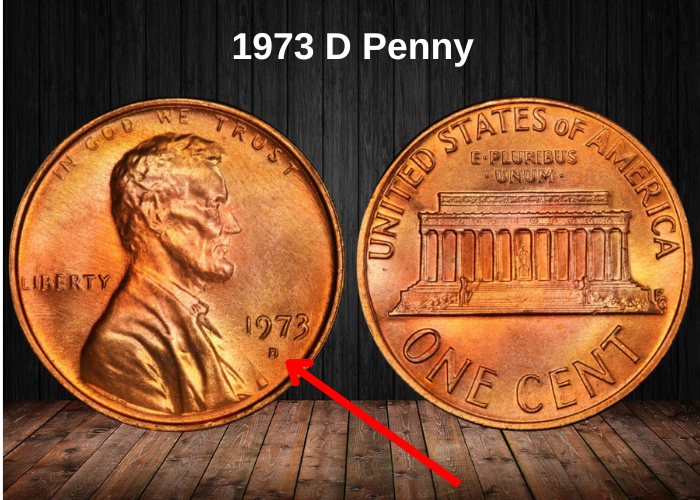
Type: Lincoln Penny
Edge: Smooth
Mint Mark: D
Mint Location: Denver
Total Minted: 3,549,576,588
Year: 1973
Face Value: $0.01
Price Range: $0.05 – $7.50
In 1973, the Denver Mint produced over 3.5 billion Lincoln pennies, so these coins are generally not considered rare. Like the Philadelphia issues, their value in circulated condition is about two cents due to their copper content. A 1973 D penny graded MS65 is worth approximately $16.
However, exceptions exist for highly graded coins. At a 2014 auction, a 1973 D penny graded MS67 RD by the Professional Coin Grading Service sold for $4,994, setting the record price for a 1973 D Lincoln penny.
1973 S Penny Value
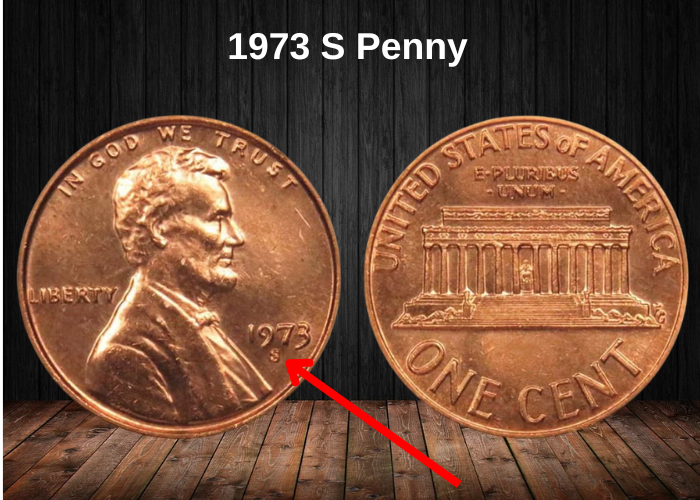
Type: Lincoln Penny
Edge: Smooth
Mint Mark: S
Place of Minting: San Francisco
Total Minted: 319,937,634
Year: 1973
Face Value: $0.01
Price Range: $0.05 – $7.50
In 1973, the San Francisco Mint struck over 300 million pennies. Similar to the Philadelphia and Denver pennies, circulated specimens are worth about $0.05, largely based on their copper content, while uncirculated coins can fetch around $7.50.
The auction record for a 1973 S Lincoln penny was set in 2016. This coin, graded MS67 RD by the Professional Coin Grading Service, sold for $2,233.
Rare 1973 Penny Errors List
1973 Lincoln Penny Doubled Die Error
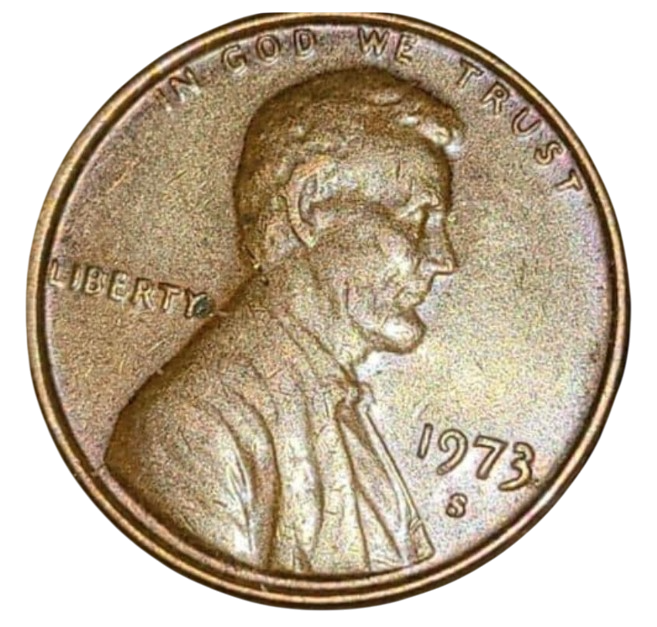
One common type of coin error that collectors search for is the doubled die error, which occurs when some elements of the coin appear duplicated. Among the 1973 pennies, there are known instances of this error. Although these coins aren’t extremely rare, they generally have a higher value than standard 1973 pennies.
That said, to be worth more than their face value, these coins must be in good condition. To identify a 1973 Lincoln penny with a doubled die error, check carefully for doubled images in the letters, the date, or details like Lincoln’s eye and bowtie. Depending on how noticeable the doubling is, these pennies typically range in value from $25 to $100.
1973 Lincoln Penny Off-Center error
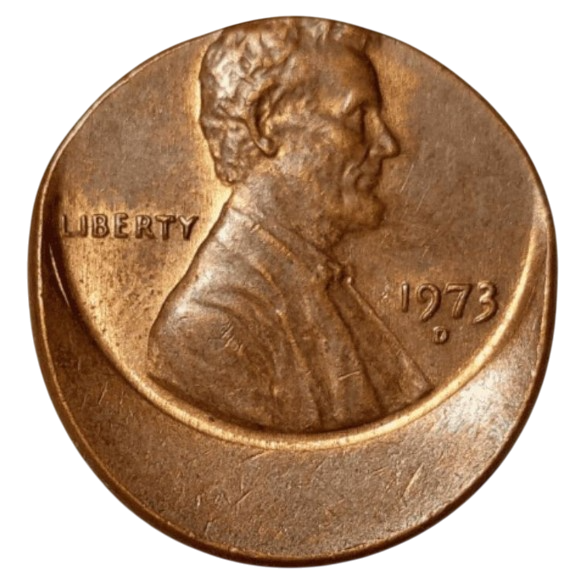
Sometimes, coins are not properly aligned when struck, resulting in what is known as an off-center error. On these coins, the design is not perfectly centered, causing parts of the image to be cut off or missing. The value of such coins depends on both their overall condition and how much the image is off-center.
For 1973 Lincoln pennies, a slight off-center error of around 5% can make the coin worth between $10 and $20, while a more severe off-centering of about 50% can increase the value to nearly $100.
1973 Lincoln Penny Repunched Mint Mark Error
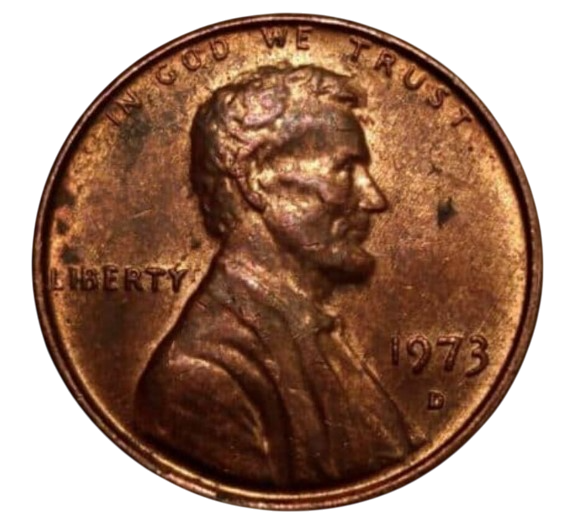
In 1973, mint marks were still applied manually, which often led to mistakes. Occasionally, the mint mark would be stamped in the wrong position or orientation, requiring the worker to punch it again.
Since these mint mark errors were quite common and usually minor, they don’t command very high prices. Nevertheless, they remain collectible and typically have a value ranging from around £3 to $10.
1973 Lincoln Penny Die Break Error
As a coin die gets older, it can develop cracks and breaks on its surface known as die breaks. These imperfections are transferred onto the coins during minting and show up as raised bumps, lines, or squiggly marks on the coin itself.
The value of a 1973 Lincoln penny with a die break error varies depending on the coin’s condition and the size of the error. Generally, these coins can be worth anywhere from $3 to over $100. A specific type of die break error on the 1973 penny, called the BIE error—where it looks like there is an extra “I” in the word “LIBERTY”—usually sells for about $5 to $10.
1973 Lincoln Penny Raised Edge Error
This mistake, often called a raised-rim error, causes the penny to have a thicker-than-normal edge due to an unusually high rim. It typically happens when the die is tilted during the minting process. While not uncommon, most 1973 Lincoln pennies with this raised edge error are valued around $10, unless they are in outstanding condition.
Where to sell your penny?
Now that you know the value of your penny, you might be wondering where to sell it. Don’t worry: here’s a guide to some of the best online platforms where you can easily sell your coins, along with their advantages and disadvantages.
Discover the best platforms for selling coins online (pros and cons).
1973 Lincoln Penny FAQs
1. What is the typical market value of a 1973 Lincoln penny?
Most 1973 Lincoln pennies are common and worth only face value (1 cent) when found in circulated condition. However, uncirculated coins (MS60 and above) can be worth between 50 cents and $5, depending on the mint mark and overall condition.
2. Were there any notable varieties or errors for the 1973 penny?
Yes. The 1973 Lincoln penny has a few minor known varieties, but none as dramatic or valuable as the 1972 doubled die obverse. Some examples include:
- Minor die cracks
- Slight off-center strikes
- Weak or missing mint marks (rare)
- Repunched mint marks (RPM) on Denver or Philadelphia coins, which can interest variety collectors but usually don’t carry huge premiums.
3. How many pennies were minted in 1973, and how does that affect rarity?
The total mintage for 1973 Lincoln cents was very high:
- Philadelphia (no mint mark): approximately 3.7 billion
- Denver (D mint mark): approximately 2.6 billion
- San Francisco (S mint mark, proofs only): about 8.8 million
Due to this high mintage, 1973 pennies are generally common and not considered rare in any grade.
4. What is the difference between the circulation strikes and proof pennies of 1973?
- Circulation strikes were made for everyday use and typically have more wear.
- Proof coins from the San Francisco mint (1973-S) were made for collectors with a higher quality finish, sharper details, and a mirror-like surface.
Proofs are more valuable, especially in high grades. For example, a PR67 1973-S Lincoln penny can sell for around $10-$15, while higher grades command even more.
5. Are there any errors collectors should watch for in 1973 pennies?
While 1973 pennies don’t have many dramatic error varieties like 1972, collectors sometimes find:
- Die cracks or breaks on the obverse or reverse
- Off-center strikes
- Clipped planchets or planchet flaws
- Slight doubling on the mint mark (RPMs)
These errors usually add modest premiums, often between $10 and $100, depending on rarity and condition.
6. How does the 1973 penny fit into the broader Lincoln Memorial series?
The 1973 penny is part of the ongoing Lincoln Memorial design era (1959-2008). It represents a period of high production and stable design before the transition to the new compositions in the 1980s. Collectors often seek complete date and mint mark sets, and 1973 is a key mid-series date.
7. How can collectors authenticate and grade their 1973 pennies?
Collectors should examine:
- Mint marks under magnification (Philadelphia no mark, Denver “D”, San Francisco “S”)
- Surface condition (wear, scratches, luster)
- Signs of errors or doubling
- Weight and thickness for clad composition
For valuable or questionable coins, professional grading by PCGS, NGC, or ANACS is recommended to ensure authenticity and establish market value.


















































